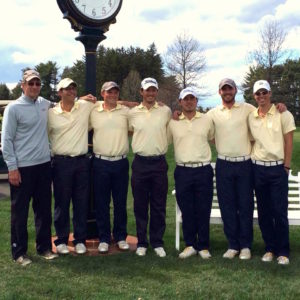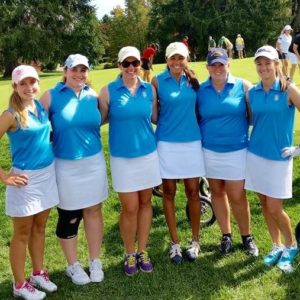Welcome to Interview #10.
I am pleased to share with you the energy of NCAA Division 3 Men’s and Women’s Assistant Golf Coach, Abby Sorensen of Allegheny College. If you are an athlete, you will find the advice in the interview well worth your time. If you are high school golfer who wants to golf in college, this is a must read.
Previously she spent two seasons as the head women’s golf coach at Division II Gannon University in Erie, Pennsylvania. In 2013-14, she guided the Gannon Golden Knights to a total of five team titles, including the Pennsylvania State Athletic Conference (PSAC) championship, en-route to earning PSAC Coach of the Year laurels.
Read on. This interview is full of priceless information!
Where do D3 golf coaches most often find players for their teams?
The short answer is everywhere. We start building our classes of recruits by looking at online profiles, and add to the list by going to tournaments to see golfers in person, reaching out to our alumni for names of talented athletes in their area, and contacting high school coaches. Of course, we always welcome a student-athlete who finds us first.
What would a timeline look like for your recruiting of a typical player? What kind of communication do you send out and when?
Typically we send out our first round of communications towards the end of a prospect’s junior year, and by the start of his/her senior year the recruiting process is in full swing. Some student-athletes make up their mind very early in their senior year, and we still have some recruits who are on the fence. The timeline varies for everyone.
What kind of scores should men and women golfers be shooting to have a chance to play D1, D2, or D3?
This is a hard question to answer, because it depends entirely on the competitiveness of a program. There are women’s D1 golfers who average in the 90s, and D3 golfers in top programs who are consistently scoring in the 70s. On the flip side, the upper tier of D1 men’s golfers can end up on the PGA Tour, and the back of the pack at the D3 level might be shooting in the 90s.

The overall competitiveness of college golf has improved greatly, especially over the past decade. If a male golfer is consistently posting scores in the mid-70s and a female golfer is averaging in the low-80s or high-70s, then I’d say they could find a good home on a competitive college program at any level. This is a great question for high school golfers to ask college coaches early in their college search process.
What is the difference between playing D2 and D3 golf? What are the yearly expectations in and out of season?
Having coached at both levels, the only difference I know of is the postseason structure and the athletic scholarship offering. Right now, D3 teams advance directly to the National Championship field, and D2 teams play in Super Regional tournaments before getting to Nationals. Otherwise, what is expected of student-athletes at the D2 and D3 level depend entirely on the coach and the program.
Our golfers at the D3 level really never stop playing. We do have an off season, but the golfers have an indoor hitting area and a simulator on campus where they keep their games sharp. We are fortunate to have a full-time head coach, a part-time assistant coach, and a volunteer assistant coach, so we keep our athletes busy! Overall though, there is not much of a difference between the levels. For example, just this past weekend our men’s team won a 13-team D2 tournament where they were the only D3 team in the field. Right now, according to Golfstat, the difference in scoring average between the number one player in D2 and the number one player in D3 is less than a stroke.
What can or should high school athletes do from their end to get on your radar screen? If a golfer personally contacts you by phone or email, what will you do next?
If a high school golfer wants to get on our radar, the best thing they can do is email or call us, and submit an online recruiting questionnaire on that school’s website. Coaches in any sport can’t possibly contact every quality athlete in every single state. If you’re not hearing from a coach, that doesn’t mean the school isn’t interested in you, it just means you need to make the first contact. It’s important to me that the athlete reaches out, not his or her parents. That shows us maturity and initiative, two things that are important in college athletics. After we hear from a prospect, we will typically respond within 24 hours, if not sooner.
I have heard there are so many women’s golf spots and scholarships that girls should take up golf just to get a scholarship. Can you either confirm or dispel the rumor?
I’m always an advocate for girls taking up the game of golf! It’s a game that can be played for an entire lifetime, and it’s a great networking tool in the business world.

However, college scholarships are not given out freely, they still have to be earned. Female golfers need to consistently post tournament scores in the 70s or low 80s to have a chance to get athletic aid. Even then, the notion of a “full-ride” is much more of a myth than a reality. To get even close to a full scholarship, a high school golfer needs to have a strong academic background so schools can combine athletic and academic scholarship.
D3 does not have athletic scholarships. Can you talk about if that matters to students financially?
Regardless of the D1, D2, or D3 level, financial aid will always play a role in the college search process. As a recent college grad with loans of my own, I know firsthand that the financial aspect of college can play a considerable role for golfers and their families. My advice is to never rule out a school based on cost until you apply and receive a financial aid package.
Also, it’s important to think of the cost of college as a 40-year investment, not a 4-year decision. In the grand scheme of things, a few extra thousand dollars in tuition only translates to a few extra dollars per month in student loan payments, and could very well be worth it for a student to attend the ideal school.
Do college golfers have to pay for green fees and travel expenses?
It depends on the program and the budget a college coach has to work with, but generally, no. In our D3 program, golfers pay a small fee their freshman year for the golf bag, which they get to keep. They do not have to pay for shirts, rain gear, hats, umbrellas, or golf balls either. All tournament entry fees, practice round greens fees, and meals/lodging on the road are covered by the team’s budget. When we take our annual spring break trip to Florida, the golfers pay for only their flights, and the rest is covered.
Certain things the golfers have to pay for themselves, per NCAA rules, such as their golf clubs or summer course memberships. It’s a good idea to ask a college coach what the out-of-pocket costs are for the golfers on their roster.
How much coaching instruction is involved for collegiate golfers? Is it like working with an individual golf pro or do they mainly go out and play?
This is one of the best questions to ask a college coach, because each coach is different. For example, Coach Groff and I are not swing coaches, and we don’t pretend to be. We see ourselves as mentors, motivators, and course management instructors, and mental game experts.
My philosophy is that each golfer comes to our team with his or her own swing, and typically his or her own swing coach, and it’s not my place to change either of these things. One of my best friends in college had the strangest golf swing I’ve ever seen, and that’s putting it nicely! However, she was also one of the best golfers to ever play for our program. She’s exactly why I don’t put too much weight on a recruit’s swing video or try to change swings, because I’d rather see proof of what that swing can do in tournaments.
When our golfers’ swings do get out of sync, we have an excellent teaching professional at our home course who can step in and help. Some of our golfers will head home for a lesson, or thanks to advancements in technology they can take virtual lessons if they are far from home. I also know of college coaches who are professional swing instructors, and even some who have played professional golf, so they are a lot more hands-on when it comes to swing mechanics.
Even though the coaches in our particular program are not swing experts, we do have some great drills and various structured practice routines that we run through to help our golfers play to the best of their abilities. In a typical practice, we have some sort of structured segment where the whole team is together, and then we let the golfers work individually. For example, if one golfer is struggling with his putter and another golfer can’t hit a fairway, it doesn’t make sense to make them hit bunker shots for two hours. Our golfers know their games the best, so we trust them to work smartly in practice.
What is the role of the parent in the recruiting process?
There’s nothing more frustrating for a coach than sitting across from a parent and a high school golfer and having Mom or Dad answer questions for their son or daughter. Parents can think of themselves as a CFO and worry about the financial aspect of a college, and the rest of the decision should be up to the student-athlete. Of course, we want all of our recruits’ families to be comfortable on our campus and in our program, and we will often call parents to get a read on where we stand in the recruiting process.
High school students should be the one typing their own emails, setting up their own college visits, filling out their own applications, and ultimately making their own decision. All of this is the first step in proving to a coach that you can be a mature and self-motivated college athlete.
Bonus Question: Is there anything important that you would like to share directly with high school athletes or golfers in particular as they navigate the recruiting process?
Be honest with yourself! One of the best things high school athletes can do for themselves is to be honest about what they want in a program. If you want to stay close to home, don’t talk to coaches across the country from you. If you have your heart set on a major and a school doesn’t have it, cross it off your list. If you want to compete for a spot in the starting lineup as a freshmen, don’t consider schools where you can’t compete and won’t be happy with your playing time.
If you are not interested in a school, it’s completely fine to tell a coach that (because we’ll keep calling/emailing/texting/writing to you until you do!). This will take a huge burden off your shoulders, and a coach will appreciate your honesty.

Profile:
Coach Abby Sorensen is currently the assistant men’s and women’s golf coach at her alma mater, Allegheny College.
Previously she spent two seasons as the head women’s golf coach at Division II Gannon University in Erie, Pennsylvania. In 2013-14, she guided the Golden Knights to a total of five team titles, including the Pennsylvania State Athletic Conference (PSAC) championship, en-route to earning PSAC Coach of the Year laurels. During her first year at the helm, the Golden Knights turned in a total of six top-five finishes, highlighted by a second-place performance at the PSAC championships.
Before coaching, Sorensen had a brilliant athletic and academic career at Allegheny College. During her career as a student-athlete at Allegheny, Sorensen was part of three squads that qualified for the NCAA Division III National Championship, while the Gators won the North Coast Athletic Conference crown in 2010-11, and finished second at the league championship in 2011-12. Individually, she turned in six top-10 finishes in her career, highlighted by a second-place effort at the 2011 Allegheny Invitational, and a seventh-place finish as the first event of the 2010 NCAC Championship Series.
Academically, Sorensen was the Allegheny 2012 valedictorian. She was named to the National Golf Association’s All-America Scholar Team following both her junior and senior seasons.
As well as being the assistant men’s and women’s golf coach, Sorensen is also currently employed full-time as a marketing/events manager at Jameson Publishing in Erie.
Next, take a look at Grades Affect Athletic Scholarships.
Keep in the Conversation,
Bryan Drotar



Way cool! Some very valid points! I appreciate you writing this post
plus the rest of the site is really good.